Leaving the hustle and bustle of the Flower Market, we took a ferry to go to Bagbazar, North Kolkata. It was exciting to drift through the mighty Hooghly River. Ferry ride is a good way to beat the morning traffic.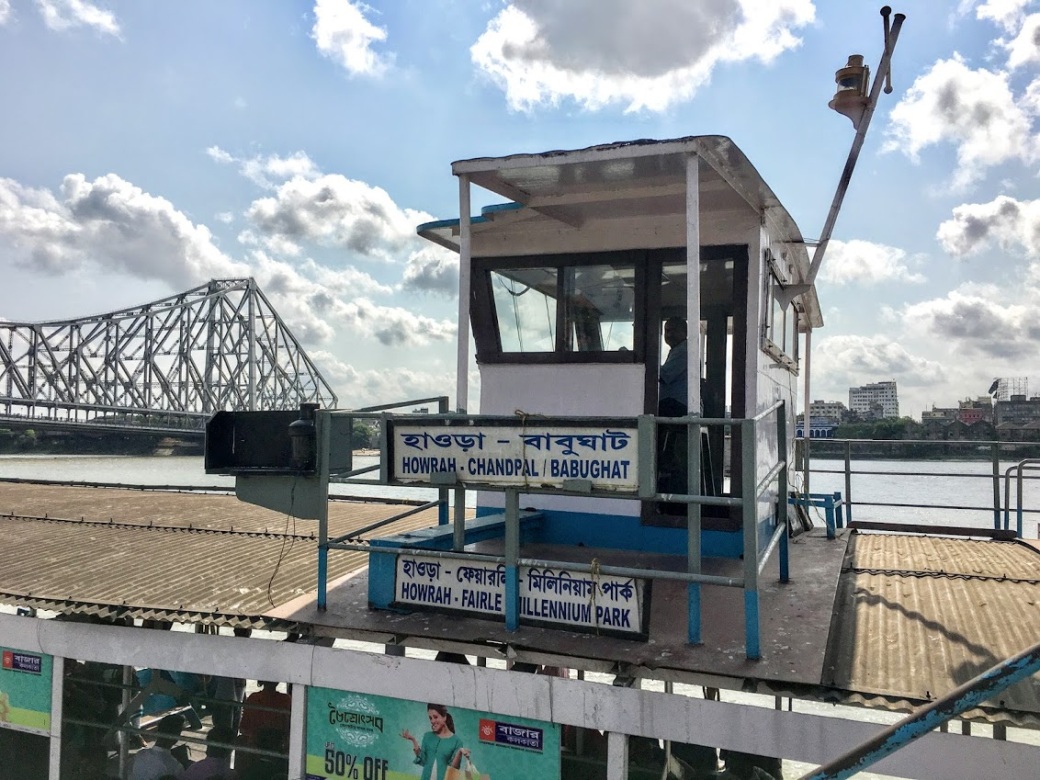
This part of the city was like the sets of a vintage Bengali movie: crumbling old mansions, trams, and hand-pulled rickshaws. One of the houses is even rumored to be haunted!

Putul Bari (House of Dolls)

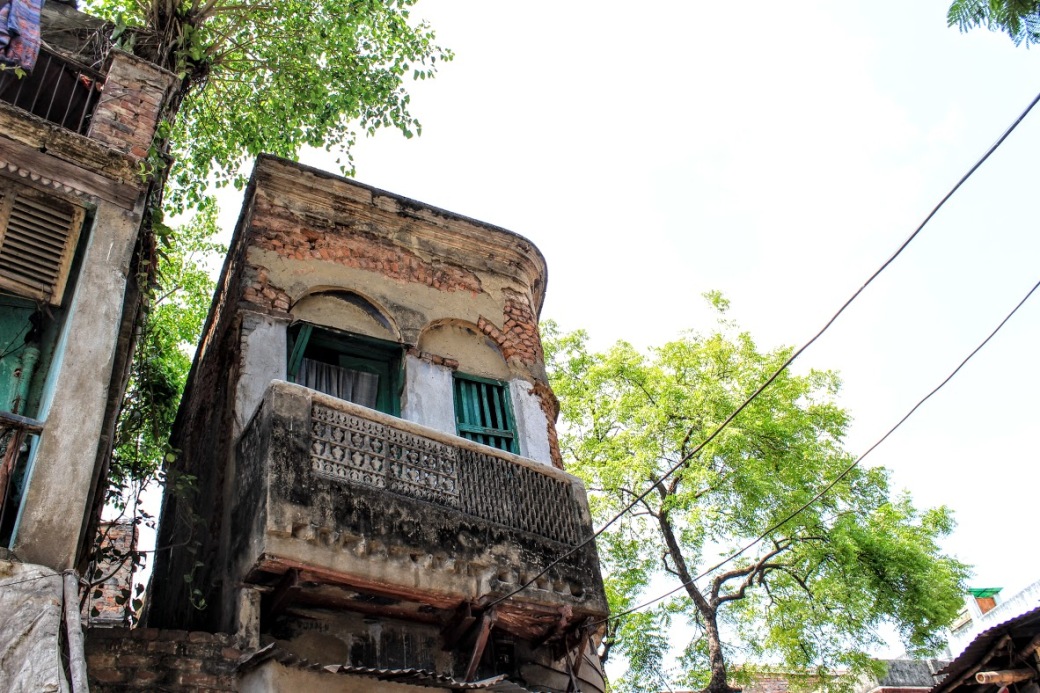
I like this cozy balcony with its intricate grill
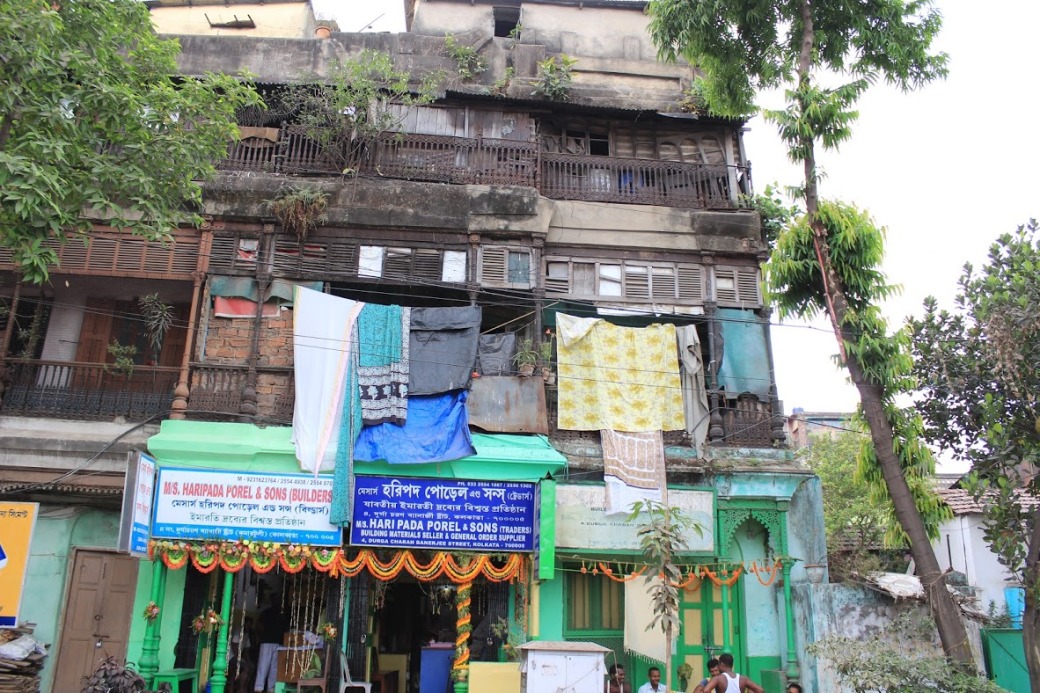
Crying for repair and restoration
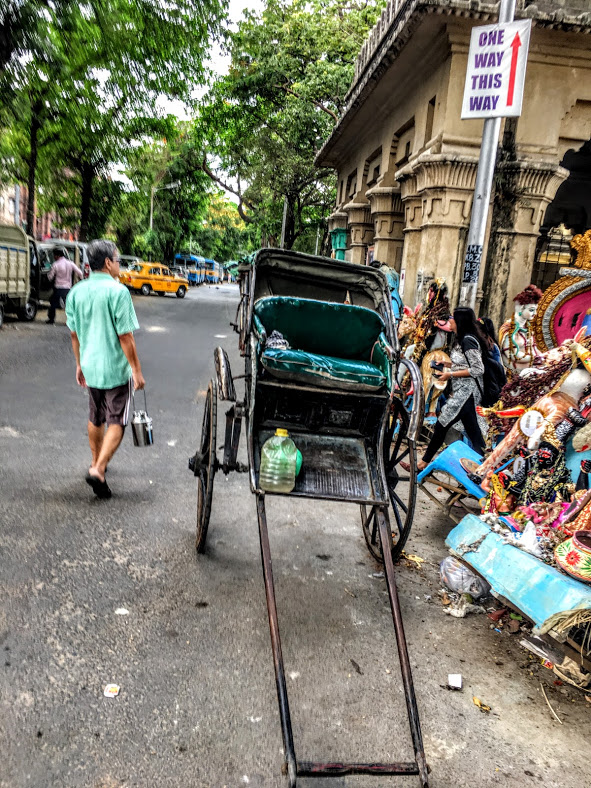
Hand-pulled rickshaw and the yellow taxi-iconic symbols of Kolkata
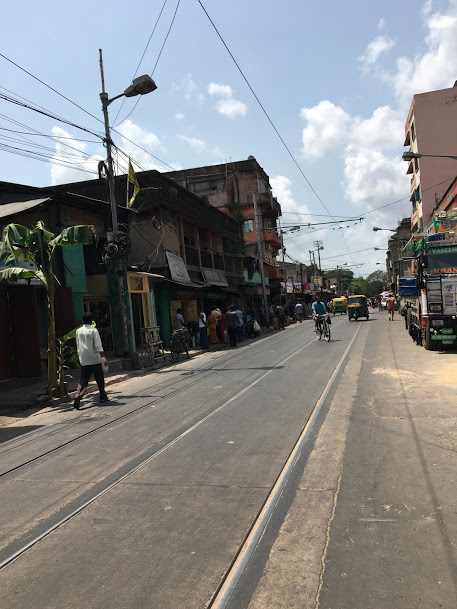
Tram tracks- Kolkata is the only Indian city with tram service and it is the oldest in Asia
Finally, we reached a warren of narrow streets lined with workshops. This is Kumartuli- the Potters’ Colony: the place of birth of Gods and Goddesses of Hindu pantheon.
Navpreet gave a brief introduction into the history and led us to explore.
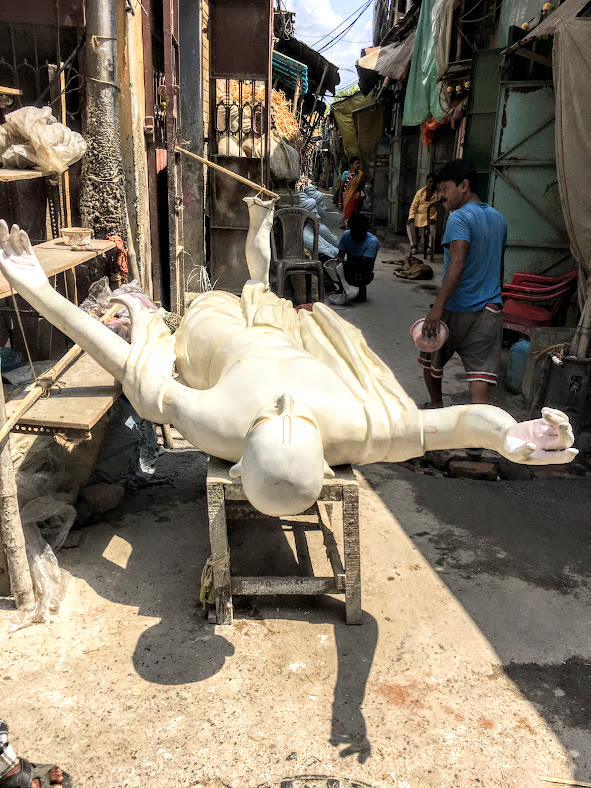
Kumartuli- where Gods are made
The tradition of idol making dates back to the 16th century when rich landlords had grand puja celebrations at their residences. The idol makers used to come from the neighboring villages. Later as pujas became a community affair there was more demand for the idols and the potters set up a permanent workshop/residence near the banks of Hooghly River. Kumartuli( In Bengali kumor is potter and tuli means locality) has since grown into a lively art community.
Bengalis celebrate many festivals all year round; Durga Puja, invoking Goddess Durga is the most popular. It celebrates the victory of the Goddess over the demon Mahishasura. During the 10- day- long festival, idols of Goddess is worshipped in thousands of marquees (pandal) all over the city. The festival is in September-October, though preparations start early.
Idol making is a long, elaborate process. Meticulous preparations start from the month of March and continue until the idols are despatched to various parts of the country and overseas.
We are here in April and today seem like any other working day for the artists. I watch the activities with awe. The artisans work silently with total concentration. The workshops are filled with statues in various stages of completion. They are carrying on an age-old craft passed from generation to generation. Everything is handmade; the raw materials used are bamboo, hay, clay, and jute.
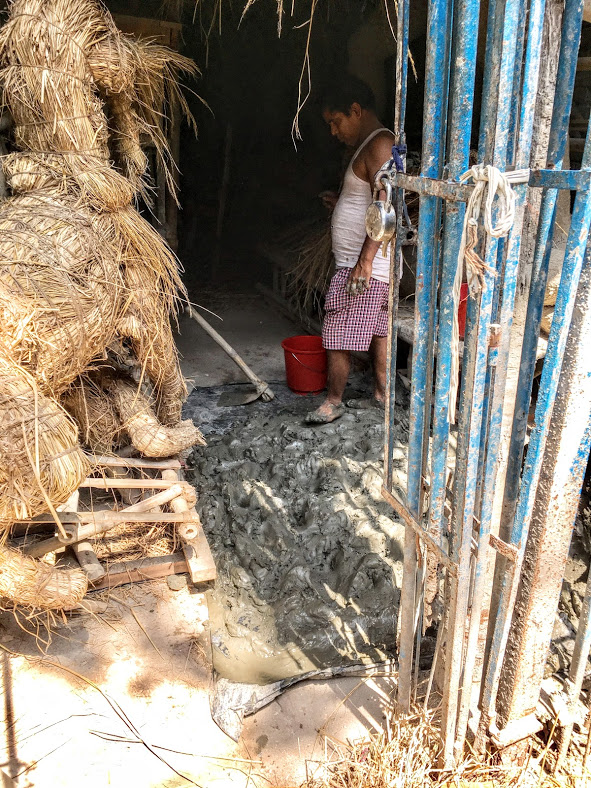
It starts by making a framework out of bamboo and hay. The skeletal frames are plastered with layers of clay and the structure is kept in the sun to dry.

The straw dummy of the Goddess Durga with ten arms. Amazing symmetry and proportion!
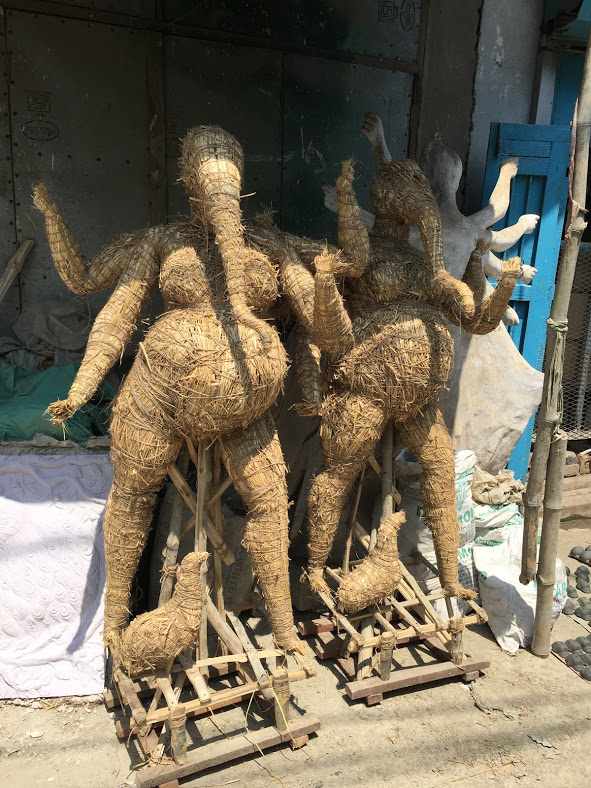
Lord Ganesha waiting for the clay coating.
The torso and limbs are sculpted first; face, fingers, and toes are moulded later.

The tiny workshop


Many faces of the Goddess
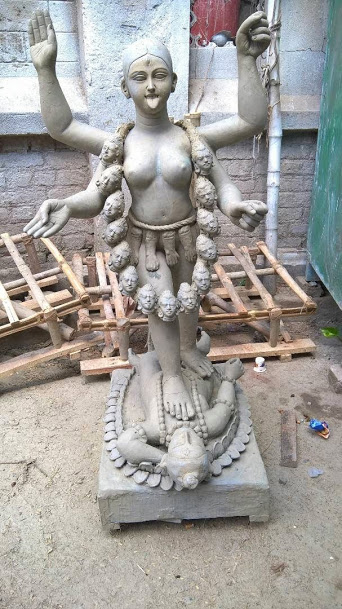
Goddess Kali

All set for the painting and varnishing
Next step is painting and varnishing. The painted models are dressed in dazzling clothes and adorned with jewelry. Thus a team of artists and ancillary workers transforms the shapeless mass of clay into a divine figure. The end product looks like this:

Goddess Durga with her children and the vanquished demon at her feet.
Navpreet regaled us with fascinating rites and rituals associated with idol making. The eyes of the Goddess is drawn on an auspicious day. Known as Chokku dan, the Goddess is supposed to descend to earth from her heavenly abode this day. I wish I can come back and see all the stages of idol making someday. It was heartening to learn that a few women are also in this predominantly male- dominated field.
From the studios, the idols are shifted to the pandals and celebrations begin. Prayers, dance, music, feasts continue until the 10th day. On the last day, the idols are taken on a grand procession and immersed in the river. Even Gods have a short lifespan!
After bidding farewell to Goddess Durga, the artists get busy with other festivals. There is a popular Bengali saying that there are 13 festivals in 12 months so the artists are making idols all year round. Their expertise is not limited to deities; philosophers, freedom fighters, political leaders, and writers are also made here.
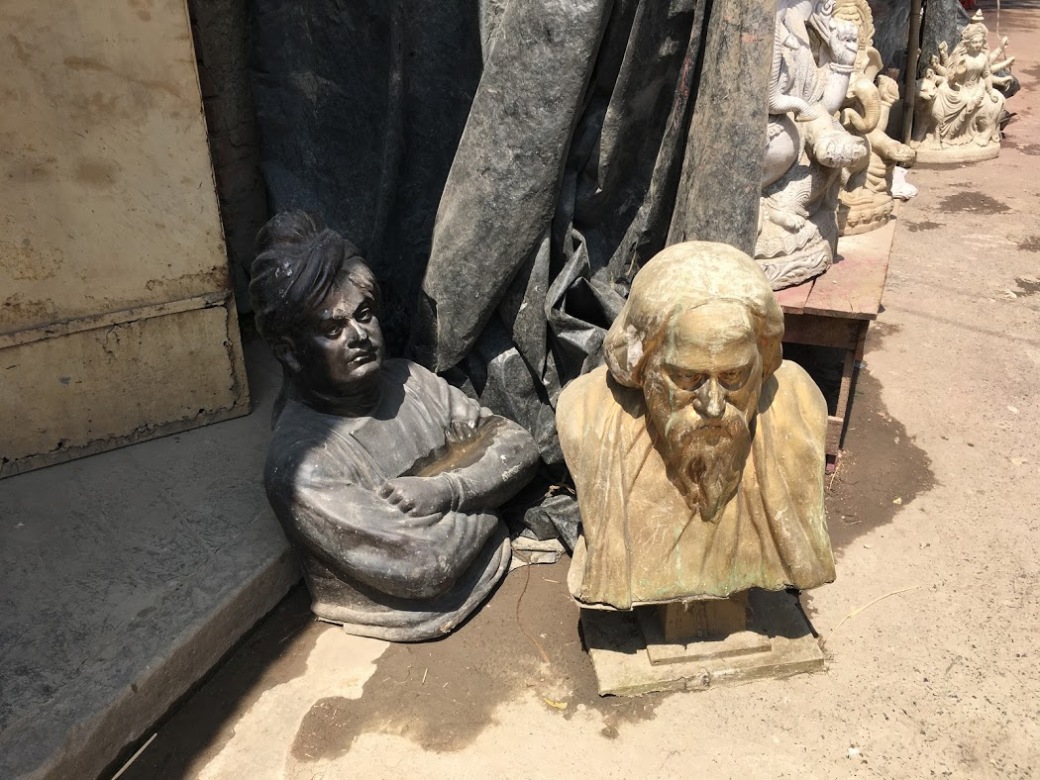
Vivekananda and Tagore
Apart from the workshops, there are many small stores with puja paraphernalia.

We chatted with this gracious artist; he is specialised in miniature idols.

The young man was totally immersed in the art using chiyari– a sculpting tool made from bamboo.

Goddess with celebrities
There is more. I see some idols dumped on the road:

Forlorn idols on the banks of Hooghly River

Languishing festal remnants. Wake up, Kolkata Municipality.
There is never a dull moment here in Kumartuli. It was a privilege to walk through this historic quarter and see the artists at work. One can’t help but notice their skills, simplicity, and the humble working conditions. I am so full of admiration and respect for the clay masters.



I am so glad to see another travel and post from your eyes and heart, dear Sidran. This is so beautiful and so interesting. I loved all these stone masterpiece houses and sculptures… Is it amazing and your expression, “…Kumartuli- where Gods are made”, fascinated me, philosophically hits.
Thank you, love, nia
LikeLiked by 1 person
It was captivating, Nia. What amazes me is the dedication and devotion of the artisans; they make life- size statues knowing well that it will not last long.
LikeLiked by 1 person
What a fantastic selection of photographs!
LikeLiked by 1 person
The God makers were more fascinating than their creations. Thank you, Mick.
LikeLiked by 1 person
Wow – I hadn’t realized how much work and artistry went into making those idols. Amazing! And those poor crumbling buildings – so beautiful!
LikeLiked by 1 person
It was shocking to know that there are people staying in those dilapidated buildings. Kumartuli was a great learning experience. Thank you.
LikeLike
Even we also have Bengali workers creating idols before Durjapuja. I have written a blog on the same..
Kolkatta is like a city which is not willing to let go of its past. It is marvelous to know that Kolkata was at some point of time like Singapore or Hong Kong A top trading port where people made fortunes and it attracted all trading nationalities like Jews, Armenians, Portuguese to name a few! It is a different story now!
LikeLiked by 1 person
I think they are yet to find a balance between the realities and ideologies. This is no City of Joy for the common man! No wonder the younger generation does not want to take up their heritage craft.
Thank you, Arv.
LikeLiked by 1 person
It is a problem almost everywhere in India. The young generation is not interested in old art & craft. I guess modern education has raised their expectations but it is not an easy situation either. They don’t have jobs but will not opt for what their father and forefathers have been doing. And these crafts don’t pay too bad. Difficult choices!
LikeLiked by 1 person
I got to know that Durga Puja celebrations has become an industry now; corporate sponsored theme pujas are a threat to the traditional artisans. The size and scale of the festivities is growing each year but do the artisans get the benefits? Their working conditions are pathetic.
Could you please share your post on the Bengali artists.
LikeLiked by 1 person
I think it is a phenomenon that’s happening everywhere. Brands and companies getting into festive occasions to get a better connect with people. Cadbury’s does it big time and so does Coke. Cadbury’s wants to eat into the share of traditional Indian sweet which is gifted big time in India during Diwali. I have written a post on this too.
I agree that conditions of artists is not improving. They are living a subsistence life. I’ll post link to my write-up in following comment.
LikeLiked by 1 person
Hope we don’t see mass production of plastic idols someday!
LikeLiked by 1 person
who knows the way things are moving? I wouldn’t be surprised if we have these idols being mass produced in China one fine day? This has happened in case of the Lord Ganesha idols.
LikeLiked by 1 person
Here it is – https://jaipurthrumylens.com/2016/10/10/durgapuja-in-jaipur-bengali-artist-who-create-idols-of-god/
LikeLiked by 1 person
Thank you very much. Wonderful to see the God makers and Gods in your city. Here even the costumes are made out of clay. Amazing!
LikeLiked by 1 person
What a truly interesting place to visit Sidran. Great commentary and photos to guide me as if I was there.
LikeLiked by 1 person
The guide and my friend made it more immersive. Thanks, Sue.
LikeLiked by 1 person
Thanks for this fascinating tour of Kumartuli. Full of life and colour, yet it looks in great disrepair. For example, the balcony with the intricate grill is beautiful, but I doubt you’d get me to stand on it. All part of the charm.
LikeLiked by 1 person
Yes, I agree. Thank you.
LikeLike
So cool to see them 🙂
LikeLiked by 1 person
Wow, I haven’t seen how Gods are made. Felt little sad about Swami Vivekananda and Tagore 🙂, we also have this kind of culture.
LikeLiked by 1 person
Thanks, Harshani. There will be buyers for the philosophers but what about those abandoned deities. Sad.
LikeLike
What a fascinating post, Sidran! I had no idea about all of this idol making. It is a dedication of belief and art.
So much technique goes into this ancient art. I love it!
Also, the aged architecture is fab. Why is that one neat place called Putul Bari (House of Dolls)? Was it …like …. a place where men could buy women?
Why are there abandoned deities?
Enough with the questions. This is a wonderful post, and I thank you very, very much! ❦
LikeLiked by 1 person
I was told that it was a warehouse with the top floor being used by the owners for their entertainment. Tales of exploits and killing of hapless women add to its spookiness.
I wish I knew why the idols are dumped; the apathy and neglect make me sad.
Thank you, Resa.
LikeLiked by 1 person
Well, it sure is one interesting place!
LikeLiked by 1 person
Indeed.
LikeLike
Lovely post, Sidran. Oddly enough, I went to Kumartuli just a few days after you posted this. I may publish a post as well, but I don’t think I can match the depth of information you provide here. It was a wonderful experience, for sure. I was stunned by the artistry I witnessed there.
LikeLiked by 1 person
What a lovely surprise! I will be looking forward to your post. I wish I had time to see and learn more about the artists and the art. Thank you, Aliza.
LikeLike
This is such a fascinating glimpse into another world: a place where gods are made! Fantastic. I love seeing a place from the river perspective and I’m glad you were able to do this in Kolkata.
LikeLiked by 1 person
It was truly a most humbling experience. Thank you.
LikeLiked by 1 person
Kumartuli looks like a place full of life and activity. What a great place to visit. And you really captured some lovely images.
LikeLiked by 1 person
It was a unique experience. Thank you.
LikeLiked by 1 person
Great post ~ your photos of this adventure take us on the ride with you. And a perfect beginning with the drift through the mighty Hooghly River, I’m with you in the belief that a ferryboat is the way to experience a bit more with travels. Cheers to further adventures and a great spring ahead.
LikeLiked by 1 person
The river, ghats, and the life around was totally absorbing. Thank you.
LikeLike
Prachtige beelden
LikeLike
Sidran, I am always fascinated by your wonderful posts. To me, they seem to come from a completely different world. The photos are from life and show the place and the people as they really are. I admire the sculptures that are made with so much skill and talent.
Yes, Sidran, it is really very inspiring and impressive to read your reports on it.
Sidran, I wish you all the best!
Rosie from Germany
LikeLiked by 1 person
One of the most exciting places I have been to! Thank you for coming along, Rosie.
LikeLike
Wat een fantastische ervaring
LikeLiked by 1 person